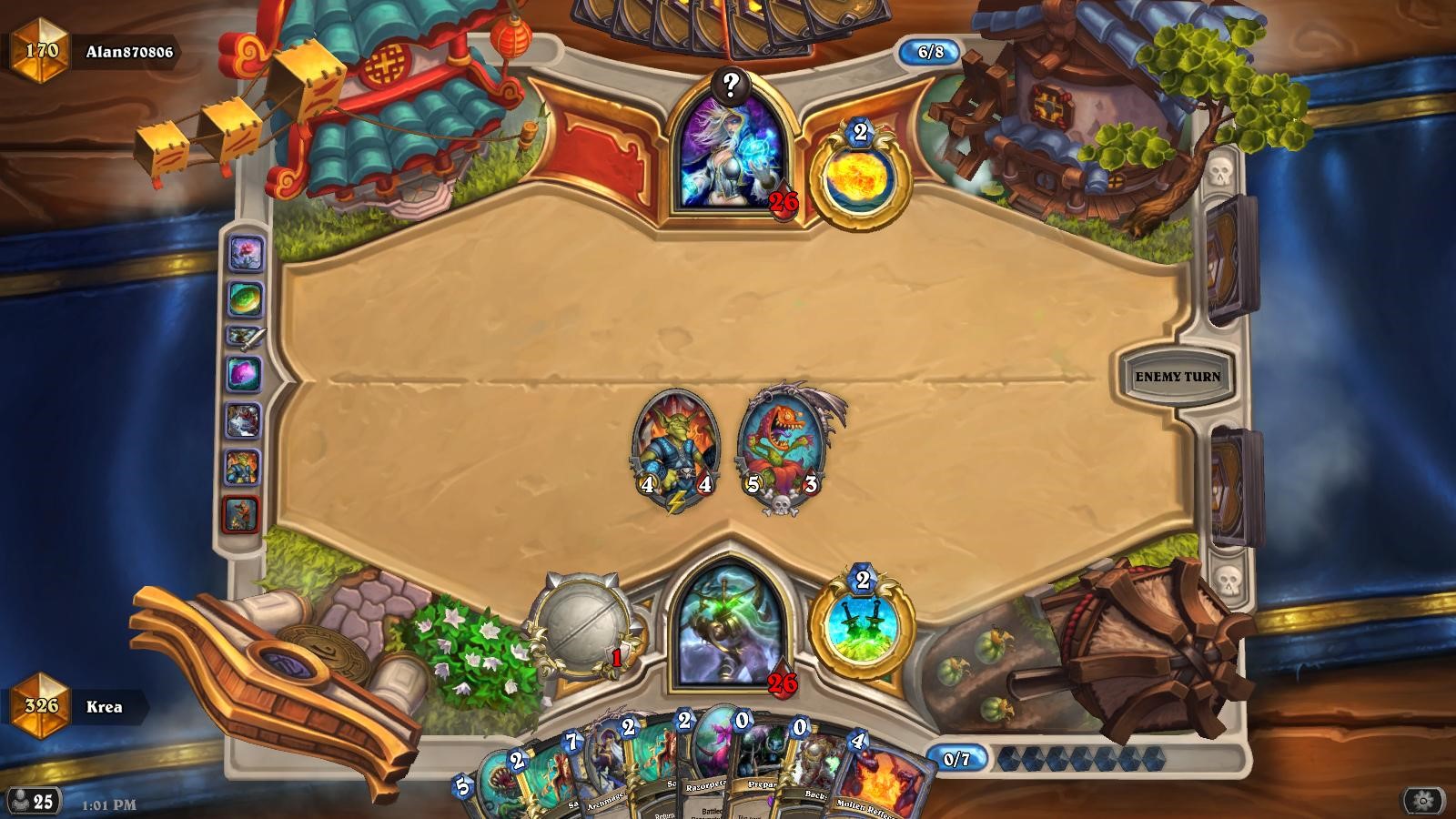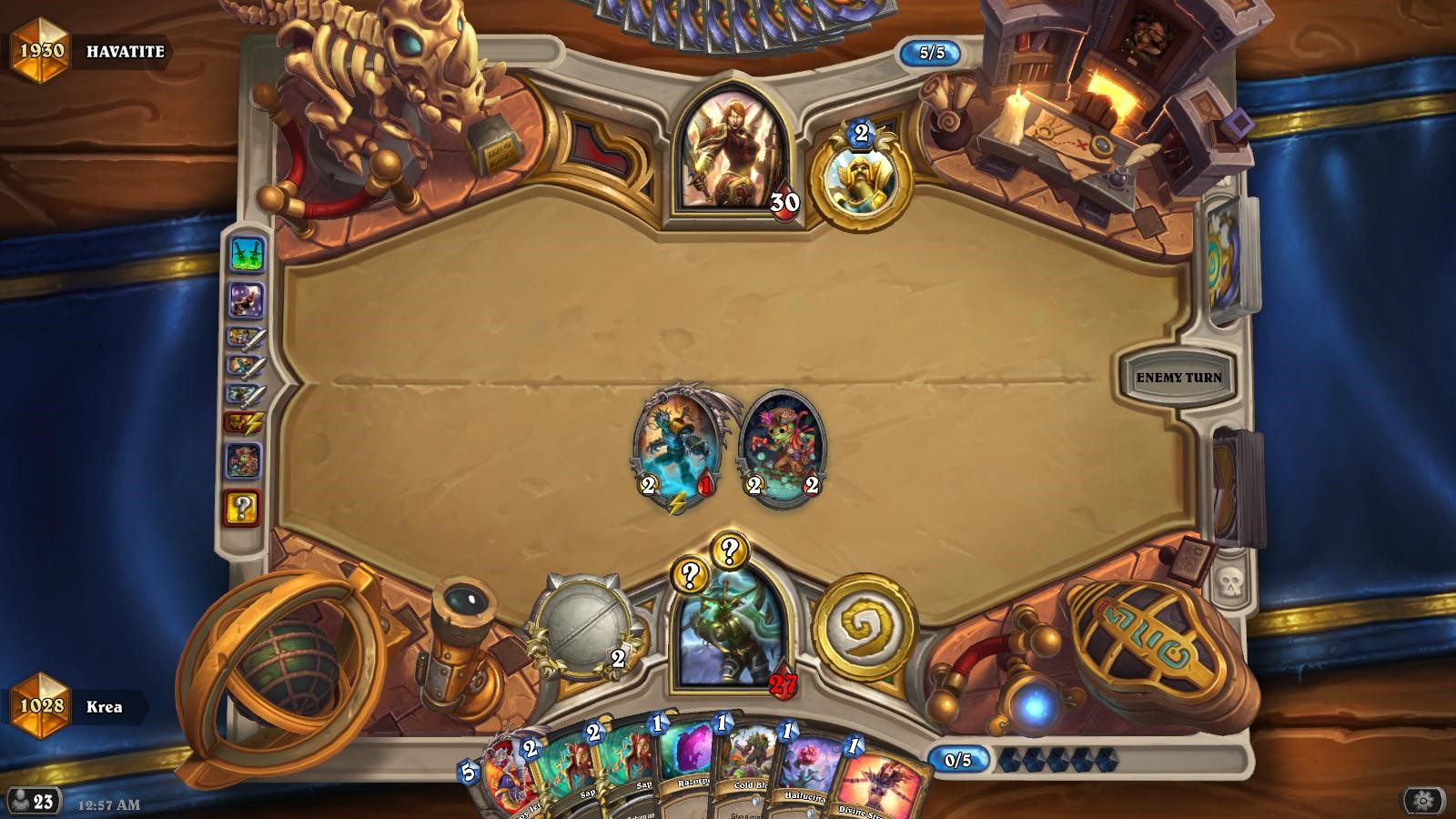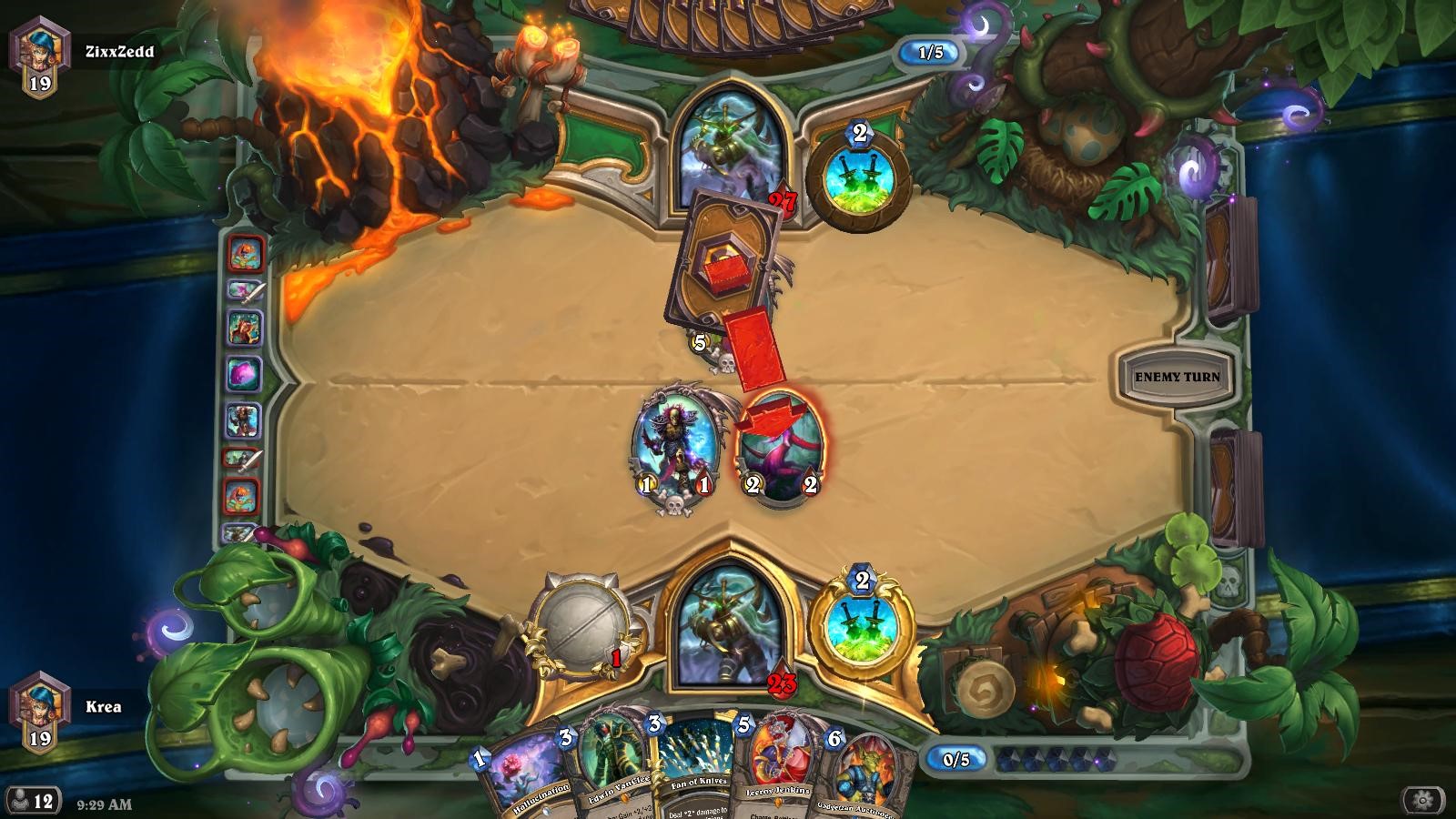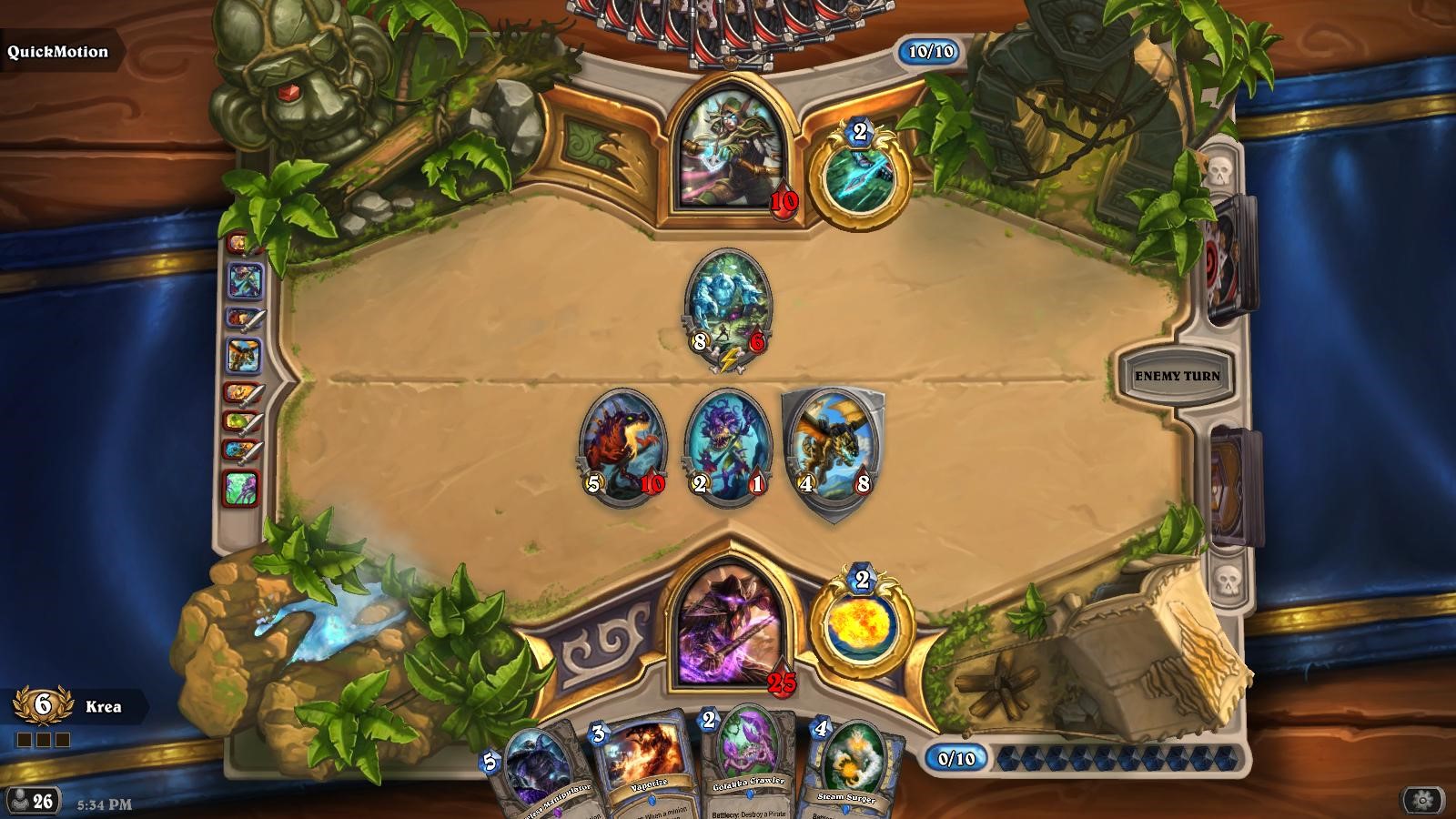Bluffing, card advantage, and hovering over cards are simple yet impactful on our overall success in Hearthstone. While these may seem like very basic things to discuss, the applying these rules to your gameplay will help to aid you in each of your matches and bring you one step closer to bettering yourself as a player.
Card Advantage
What is card advantage? The broadest definition of card advantage is a way to indicate one player having access to more cards than another player, usually by drawing more cards through in-game effects. This definition can be seen here and is a great starting point for defining the term. In the context of Hearthstone, this term remains unchanged and applies when one player has more cards in their hand than the other player. This is not to be confused with board control, a term which defines when a player has a commanding board state over the other player.
The image above is a great example of board control vs card advantage. I do have board control, which is clear because my board is positioned in such a way that I dictate how my opponent must clear it. However, what’s more important to note is that I have card advantage. I have nine cards at my disposal while my opponent only has five cards in their hand at their disposal. This means that at any given time, I have more options available to me to react to the board or to potentially make a power play if I want to attempt to secure board control in a future turn should I lose it.
It’s worth noting, however, that just because you have card advantage does not mean that you are in a winning position. This next image is a great example of that. While I do have two more cards than my opponent, I have no way to actually utilize these cards to my advantage. When thinking about card advantage, it’s important to consider the context in which it is actually a beneficial thing to have. The best way to do this is to observe what types of decks typically want to have card advantage.
Generally speaking, there are two main types of decks that will want to incorporate card advantage into their strategy when attempting to win. These archetypes are control and combo decks. Control decks seek to win the game by using a large array of reaction based cards to maintain board control, while also maintaining a high life total. They aim to control the board using as few tools as possible, which is where card advantage comes in.
A great example of this type of deck is Taunt Warrior, also known as Quest Warrior. A control deck will aim to get as much value as possible out of their removal tools in order to maintain card advantage. For example, if you are playing Taunt Warrior and have a Brawl in your hand, but your opponent only has two minions on the board and you have one taunt minion on the board, it would be better to save the Brawl for a more dire situation where the enemy’s board vastly outweighs your own. By saving your removal for a better fit situation, you maintain card advantage and will generate more value out of your Brawl than if you were to use it on only two minions.
Combo decks also wish to utilize card advantage. In the context of a Combo deck, a player will want to cycle through their deck to assemble their game winning combo as quickly as possible. Some examples of this archetype are Silence Priest and Miracle Rogue.
In the image above this, you can see that I have combined Gadgetzan Auctioneer and multiple cheap spells to assemble a draw engine. This allows me to cycle through my deck at a rapid pace while simultaneously maintaining board control through the use of cheap, yet efficient removal that is available to Rogues. By generating card advantage through the use of Gadgetzan Auctioneer, I now have many more tools to deal with whatever my opponent may throw at me, but more importantl, I am much closer to assembling my combo which will give me one of many routes to victory. In this specific case I am referring to the card Arcane Giant.
Bluffing
Now that we’ve covered card advantage, let’s talk a little bit about bluffing. Bluffing is defined as trying to deceive someone as to one’s abilities or intentions. You can in fact bluff in Hearthstone and there are many ways to do it. One of easiest ways to bluff in Hearthstone is through the use of Secrets. This is because of the inherent nature of a Secret card. All Secrets share the same mana cost as other secrets available to that class, and when played they are hidden, only to be triggered when their conditions are met.
In this example, the most recent Secret that I had activated was , which is a Secret that will return one of my minions back to life with one health upon dying. The bluff is that given the context of the board state, my opponent will likely have no idea what the Secret in play is. More importantly, it could be Repentance, which would mean that whatever minion they play would have its health reduced to one. This means that it would be correct to play a low-cost minion first, to test for Repentance. However, if they were to do that, they would have to waste some mana on a small minion, which may both ruin their curve and prevent them from playing a more powerful minion for Five mana.
There are many other Secrets that it could be as well, and in order for my opponent to figure out which secret is in play, they would have to play their turn(s) out inefficiently, often not playing on curve or making lines of play that are sub-optimal in order to clear the secrets. This is one way that bluffing can be useful.
Another way that bluffing can be useful is by using a card to target an enemy minion and then canceling the animation. While this does give the opponent information about your hand, in this case, that you have targeted removal, it can mislead them into playing their hand more slowly in fear of that targeted removal.
Here’s an example. You’re playing Rogue and have discovered a Freezing Potion off of your Swashburglar. Generally speaking, this card isn’t that useful. However, you can use it later in the game to target an enemy minion and then cancel the animation. If you’ve been holding on to the card for a while, the enemy may believe that it is a much more powerful card, such as Fireball, Meteor, or Pyroblast, which could cause them to play in a suboptimal manner in anticipation of the removal. Using this tactic, you can buy yourself a turn or two to draw into some real answers for the enemy’s board or while looking for lethal.
Hovering Over Cards
This last section will cover hovering over cards. Unlike bluffing, where you want the enemy to see the animation of your spell targeting something, this is the opposite thing that you want to be doing. Generally speaking, hovering over cards will signify to the enemy that you have a specific answer but are debating whether to use it or not due to having multiple other efficient answers to a given board state.
In this example, my opponent consistently would hover over that middle card whenever I played a large minion. The card had also been in their hand for a few turns, so I immediately knew that it was some form of removal but they couldn’t decide when they should use it. Turns out, the card was Hunter's Mark, a card which reduces a minion’s health to one. They then combined it with Unleash the Hounds to clear two of my minions, which shifted board control to them while still giving them six mana to develop a new minion. In an earlier turn, I had considered using my Faceless Manipulator to copy my opponent’s Frozen Crusher but held off after continually seeing them hover over that middle card and hovering their cursor over my Volcanosaur, highlighting it in red.
Yes, your opponent can see when you hover over their cards with their cursor, so pay attention! Watching how your opponent reacts to your plays, by hovering over cards in their hand or on the field is a great way to gain information that you would not normally have if you were alt-tabbed or had the game minimized while it’s not your turn.
That’s all for this section. I hope you guys learned something new today! Let me know your thoughts and good luck on the ladder!
Guide by Krea






